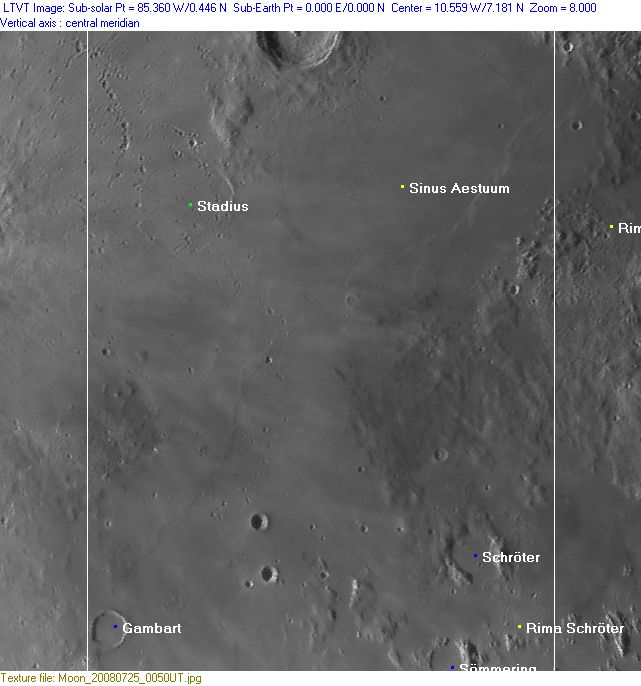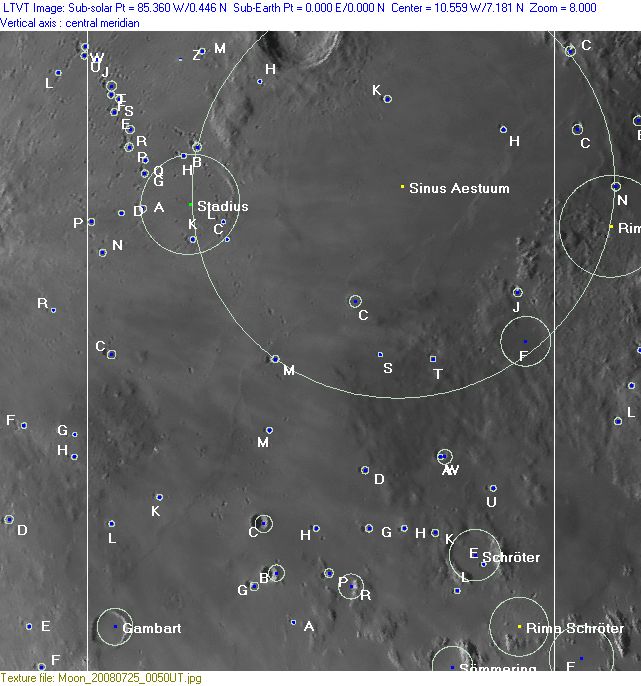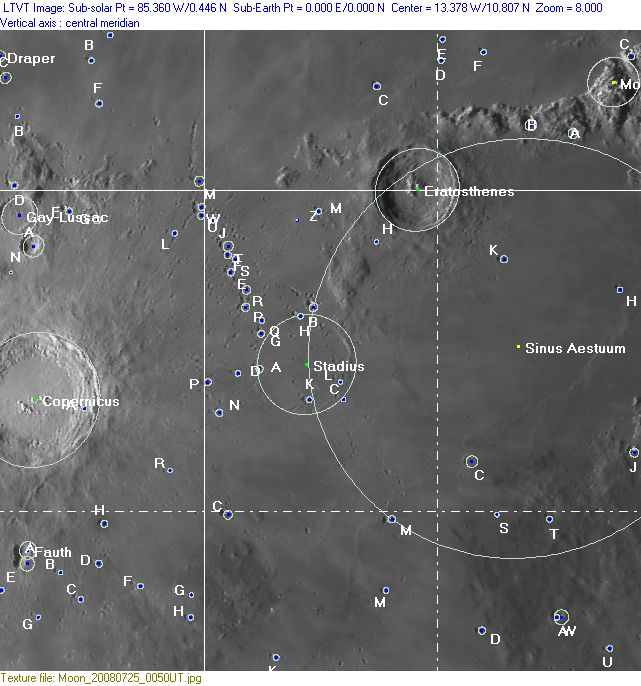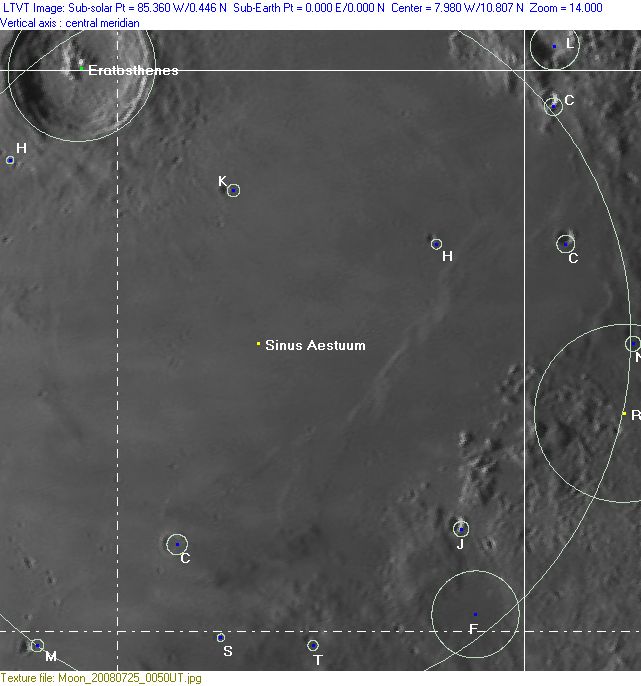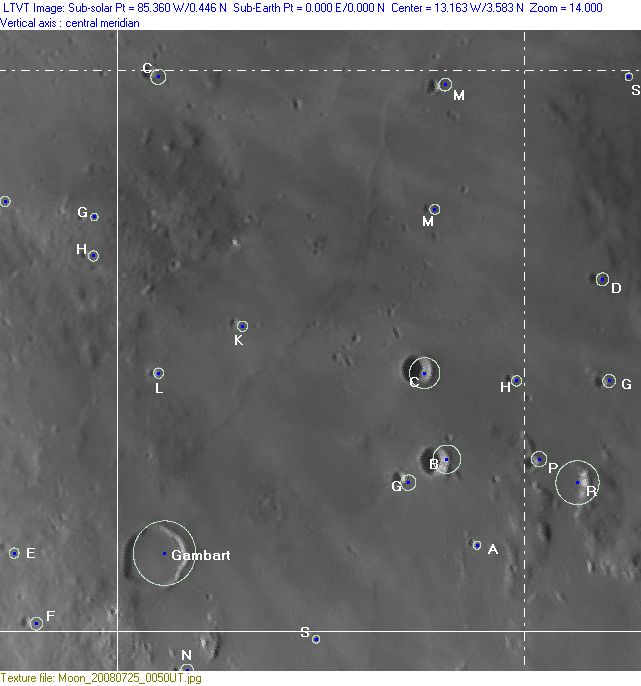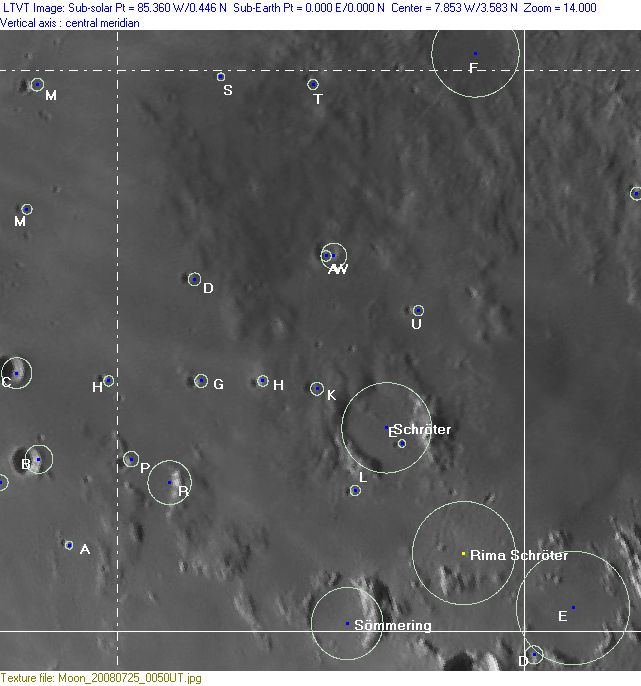Rükl 32
Contents
Rükl Zone 32 - STADIUS
Neighboring maps on the Rükl Nearside Map:
Table of Contents
[#Rükl Zone 32 - STADIUS Rükl Zone 32 - STADIUS]
[#Rükl Zone 32 - STADIUS-Photographic Map Photographic Map]
[#Rükl Zone 32 - STADIUS-Named Features Named Features]
[#Rükl Zone 32 - STADIUS-Lettered Crater Locations Lettered Crater Locations]
[#Rükl Zone 32 - STADIUS-Additional Information Additional Information]
[#Rükl Zone 32 - STADIUS-Gruithuisen's Lunar City Gruithuisen's Lunar City]
[#Rükl Zone 32 - STADIUS-Surveyor 2 Surveyor 2]
[#Rükl Zone 32 - STADIUS-WARNING: WARNING:]
| 32 |
||
Photographic Map
(This map is based on an Earth-based photograph that has been computer-corrected to zero libration. The vertical white lines indicate the left and right boundaries of the Rükl rectangle)
Background image source
Named Features
- Aestuum Pyroclastics (an unofficial name for the rough region at the same location of F.v.P.Gruithuisen's so-called "lunar city", north-northwest of Schroter). This name (Aestuum Pyroclastics) is incorporated on chart 17 of the 21st Century Atlas of the Moon (C.A. Wood/ M. Collins).
- Catena Gambart G (an unofficial name from D.Caes for the chain of depressions immediately west-southwest of the bowl shaped crater Gambart G) (note: the chain east-southeast of Beer looks more-or-less the same, see Chart 21).
- Dominicus Maria (a disallowed name from Riccioli for one of the dark areas east or east-southeast of Copernicus, along with the other dark areas Rheticus and Stadius).
- Dorsa Aestuum (an unofficial name from D.Caes for the pronounced system of wrinkle ridges in the southeastern part of Sinus Aestuum).
- Dorsum Schroter M (an unofficial name from D.Caes for the wrinkle ridge running across Schroter M, all the way toward the region of Gambart, at south-southwest) (this must be the continuation of Dorsa Aestuum).
- Eratosthenes (Van Langren's Haro, J.Hewelcke's Insula Vulcania) (this is the pronounced crater at the upper margin of Chart 32) (see Chart 21 for the northern half of the crater) (see also Additional Information below) (note: on the Strasbourg forgery of Van Langren's map this crater was called Campinii).
- Gambart
- Gambart L's radial spokes (not really a name) (this is the system of bright and dark spokes on the inner slopes of craterlet Gambart L, north of Gambart itself).
- Gruithuisen's "Lunar City" (see description at the lower part of this page; Additional Information).
- Lacus Herculeus (J.Hewelcke's disallowed name for the three dark spots southeast of Copernicus) (see also Riccioli's Dominicus Maria).
- Montes Chalcidici (J.Hewelcke's disallowed name for the ejecta ray east of Copernicus).
- Montes Eratosthenes (an unofficial name from D.Caes for the mountains south-southwest of Eratosthenes, north-northeast of Stadius).
- Moreux (a disallowed name from F.C.Lamech for the pronounced bowl-shaped crater Gambart C, which is the northern one of the distinct couple east-northeast of Gambart itself) (seems to have been called Dantes by Riccioli).
- Oval Rays (an unofficial name from D.Alter for the curious curved shapes of some of the ejectarays of Copernicus).
- Palus Nimborum (Riccioli's discontinued name for the region near the lower margin of Chart 32).
- Rima Schröter
- Rimae Stadius (discontinued (?) IAU name)(also known as the Stadius Craterlets).
- Schröter
- Schroter swirls (an unofficial name from D.Caes for a possible field of very weak Reiner-gamma type swirls east of Schroter) (this is the mare-like region between Schroter and Sinus Medii) (to see this field of possible swirls, one should take a look at the shadowless WAC albedo-mosaic of the LROC's Act-React Quick Map).
- Schroter's keyhole (a nickname from D.Caes for the keyhole-shaped depression just north of Schroter, west-southwest of Schroter U).
- Schroter D's radial spokes (not really a name) (these are the curious dark radial bands (spokes) on the inner slopes of Schroter D, northwest of Schroter itself).
- Sinus Aestuum (Van Langren's Fretum Catholicum, J.Hewelcke's Sinus Hipponiates).
- Sinus Tarantinus (J.Hewelcke's disallowed name for the region at Mosting and Sommering).
- Sömmering
- Sommering R (the eastern part of this incomplete crater's rim shows several low-albedo streaks which are noticeable on the LROC's Act-React Quick Map, WAC mosaic).
- Stadius
- Stadius-Gambart C ghost (a nickname from D.Caes for the curious remains of what seems to be a large circular arrangement of small rays from secondary impact craterlets, of which the origin should be Copernicus in the northwest) (note: this could be the region in which Riccioli named three dark spots: Dominicus Maria, Rheticus, and Stadius).
- Surveyor 2 (crash-landed on September 23, 1966, see Additional Information below for Surveyor 2's faux crash site on Antonin Rukl's original printed version of his Chart 32) (east-northeast of Gambart C, aka Moreux).
- Thin boat (a nickname from D.Caes for the small elongated depression with elevated rim northeast of Schroter, at LAT 3.52 / LON -6.28).
Lettered Crater Locations
(click on the thumbnails to display full-sized images; use browser BACK button to return - the dashed white lines are the midpoints of the Rükl zones)
Full zone with lettered craters:
Lettered craters by quadrants:
| North West |
North East |
| South West |
South East |
Additional Information
- Other online descriptions of features in this Rükl map section:
Gruithuisen's Lunar City
This is the region of Franz von Paula Gruithuisen's famous "Lunar City" (north-northwest of Schroter), which is, in fact, a real Trompe l'oeil effect, created by the sun's grazing light (after sunrise/ before sunset) and a system of (more-or-less parallel) ridges. - DannyCaes DannyCaes Nov 11, 2008
Surveyor 2
There seems to be an error in Rukl's original chart 32, because the location of Surveyor 2's crash site is NOT 4° North/ 11° West (immediately east-northeast of the bowl-shaped crater Gambart C), it is 4° SOUTH/ 11° West (about 70 kilometers west of Lalande, on Rukl's chart 43). True location discovered by Patricio Leon (aka Nunki).
WARNING:
Those who want to create a large assembled moonmap of Antonin Rukl's 76 small charts (of the moon's near side from his Atlas of the Moon) shall notice a shift of about one millimeter to the left at the northern half of Eratosthenes (on the lower margin of chart 21). The southern half of Eratosthenes (on the upper margin of chart 32) shows a shift of about one millimeter to the right. If you want to make enlarged photocopies of all 76 charts (say: at 200 percent of the original prints) keep in mind that the shift at Eratosthenes will be 4 millimeters! (almost half a centimeter). Crater Manilius (on charts 23 and 34) shows the same phenomenon.
- DannyCaes DannyCaes Jan 24, 2016
This page has been edited 1 times. The last modification was made by - tychocrater tychocrater on Jun 13, 2009 3:24 pm - mgx2
